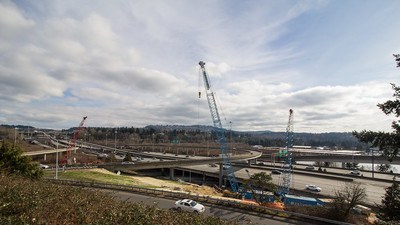 Residents in just about every state have some level of complaint about local highways and roads. In many cases, they have every reason to be unhappy about the general disrepair, but passenger car drivers are not operating a heavy commercial vehicle that weighs upwards of 80,000 pounds traveling at high rates of speed. Those are factors professional truck drivers must consider when traveling on the worst highways in America.
Residents in just about every state have some level of complaint about local highways and roads. In many cases, they have every reason to be unhappy about the general disrepair, but passenger car drivers are not operating a heavy commercial vehicle that weighs upwards of 80,000 pounds traveling at high rates of speed. Those are factors professional truck drivers must consider when traveling on the worst highways in America.
Trucking industry professionals should take note of the following information about the worst roads in America to help our valued truckers deliver their loads without incident and get home safely.
5 States Truckers Say Have Most Dangerous Roads in America
According to the National Highway Traffic Safety Administration’s (NHTSA) data, large trucks were involved in 2.8 percent of crash fatalities nationwide, totaling 841 fatalities in 2017. Although that number pales in comparison to 44.3 percent of passenger vehicles and 33.8 percent of light truck deaths, statistics indicate these trucker tragedies are on the rise.
Heavy vehicle fatalities rose from 805 (2.3 percent) in 2007 and 723 (2 percent) in 1997. All indications point to more tragic accidents and loss of life. While there are numerous factors behind collisions, being mindful of inherently dangerous highways and roads can help avoid critical situations and save lives. According to anecdotal information supported by hard data, working truckers reportedly ranked these among the most hazardous states to drive"
- Colorado: Professional CDL holders point to wide-open roadways and the presence of black ice as a reason why the Rocky Mountain state sustained a 4.8 percent large truck fatality rate in 2017.
- Texas: Truck drivers generally give props to the Lone Star state as being trucker friendly, but speed continues to play a factor in accidents. Many highways allow limits of 75 mph, which is higher than most states. Texas State Highway 130 and others allow drivers a top speed of 80-85 mph.
- Alabama: Some professional drivers cite logging trucks as a reason that this southern state struggles with safe conditions. These vehicles tend to be more cumbersome than others when fully loaded. Statistically speaking, Alabama stood below the national average for percentage of large truck fatalities in 2017.
- Oklahoma: Reports do not necessarily indicate that this state ranks among the worst roads in America. Rather, CDL drivers point to severe spring weather, sudden thunderstorms, and tornadoes as reasons for increased vigilance when driving through poor weather conditions. The Sooner state posted a 4.8 percent fatality rate, well above the national average.
- North Dakota: This state posted the highest death rate in the country at 8.3 percent in 2017, which is slightly down from 8.8 in 2016. It’s worst year, statistically, came in 2013 when the state posted 13.8 percent against a national average of only 2.6 percent. Truckers consider the icy road conditions a significant risk factor.
According to the NHTSA, New Mexico (5.7), Idaho (5.8), Wyoming (6.0), and Iowa (6.0) had the highest percentage of large truck accident deaths in 2017.
5 States with Worst Roads in America Based on Deficiencies
Another way to consider where the worst roads in America are located is to view them through a construction and upkeep lens. Business Insider pieced together a research article based on items such as road conditions, cost per motorist, structurally deficient bridges, and other factors. The states with the worst roads in America based on this analysis may surprise even veteran truckers.
- Pennsylvania: Reports indicate that 30 percent of the state’s roads are considered in poor condition, and 18 percent of all bridges are structurally deficient. Pennsylvania's motorists pay $610 annually toward better roadway infrastructure.
- Mississippi: According to reports, the Magnolia state struggles with 30 percent of its roads being subpar and an 11 percent rate of bridge deficiency. Resident drivers pay $820 annually toward improvements.
- West Virginia: Although this mountainous region is reportedly making improved road condition strides, 31 percent of its roads are still in poor condition, and 18 percent of the bridges are structurally deficient. Motorists pay a reported $723 annually toward road repairs.
- Oklahoma: According to data, 33 percent of the Sooner state’s roads are in poor condition, and 14 percent of its bridges are deficient. Drivers pay $900 each year for second-worst in the nation.
- Rhode Island: It only comes as a surprise that the smallest state in the union has the absolute worst roads in America to those who have not had the "pleasure" to experience the driving conditions. According to reports, 53 percent of the state’s roads are in poor condition, and 23 percent of its bridges are structurally impaired. Motorists in Rhode Island pay a reported $823 annually for bad roads.
States such as New Jersey, California, Missouri, Louisiana, and New Mexico round out the list of 10 states with the worst roads in America in the report. An analysis by Transportation for America detailed what the organization deemed worsening conditions. Its Repair Priorities 2019 report cites the top five states with the worst roads as Rhode Island, California, Hawaii, Connecticut, and New Jersey. The organization’s report is primarily based on ongoing neglect and roads considered in poor condition in 2017.
5 Worst Highways in America Based on Fatalities
Another way of looking at the worst highways in America is to consider that commercial rigs and passenger vehicles occupy the same travel lanes and face similar dangers. Data compiled about where most deaths occur per mile is a worthwhile way of understanding the deadliest highways in the nation.
- I-95 (Miami, FL to Weston, MA), 0.73 fatalities per mile.
- I-17 (Flagstaff to Phoenix AZ), 0.84 deaths each mile.
- US 192 (Four Corners to India Atlantic, FL), 0.87 deaths per mile.
- I-45 (Dallas to Galveston, TX), 1.02 fatalities per mile.
- I-4 (Tampa to Daytona Beach, FL), 1.25 fatalities per mile of highway.
The data used to calculate the top 5 deadliest highway stretches in the country was reportedly compiled from statistics running from 2011-2015.
5 Highways that Pose a Heightened Danger
While anecdotal and statistical information highlight the increased risks truckers and passenger vehicle drivers face on America’s highways, there are certain stretches of pavement that can quickly become hazardous. These are five roads worthy of increased caution.
- Dalton Highway in Alaska: The main road for truckers from Fairbanks to the northern areas of the state, it is infamous for dangerously icy driving conditions.
- Interstate 10 in Arizona: The 150 miles comprised of long desert stretches from Phoenix to California tends to lull drivers into inattention.
- Highway 550 in Colorado: Reaching elevations of 11,000 feet, the weather can be erratic, icy, and the stretch lacks guardrails.
- I-95 in Florida: The 380-plus miles in the Sunshine State records a high number of accident fatalities, largely attributed to distracted driving.
- Highway 2 in Montana: High rates of speed and the highway’s inherent remoteness can be a recipe for danger.
We hope this information proves valuable for the hard-working men and women of the trucking industry who drive the open road. For more trucking news and to find the latest truck driving job openings, visit CDLjobs.



